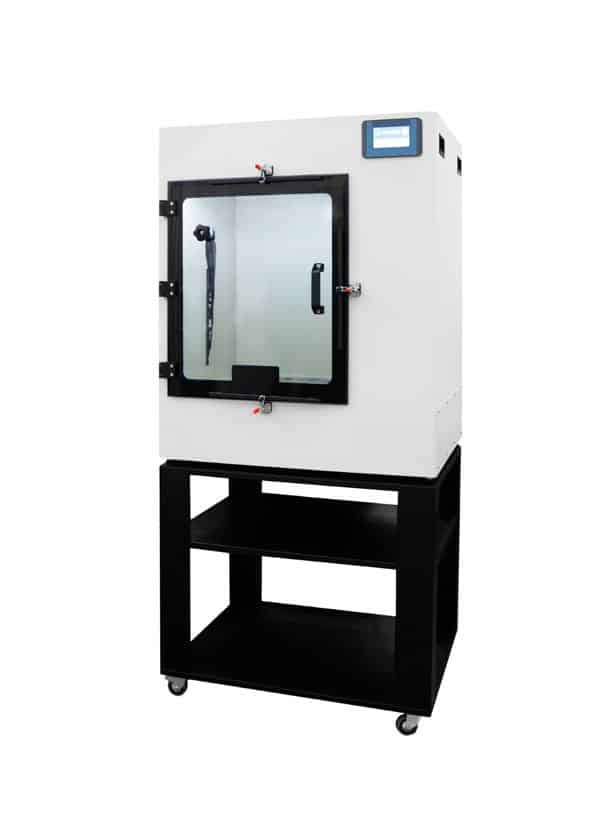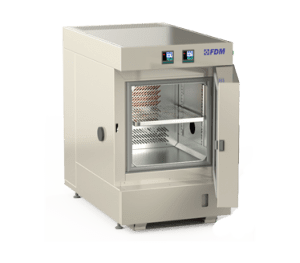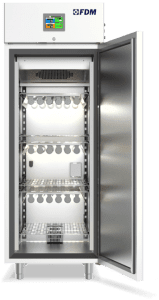
A lot can be said about the difference between laboratory incubators and climatic chambers. Both are the basis of scientific research and are widely used today in several applications.
For clarity’s sake, however, the differences may be simply grouped:
incubators create environments; climatic chambers simulate extremes.
This basic difference might not be suitable for those who are not familiar with this specific field of application.
However, from this distinction a vast array of things follow, that can be summed up by saying that lab incubators are generally used to grow cultures and climatic chambers are more used for industrial testing.
Let us deepen the above.

Laboratory incubators create environments and are usually used to grow cultures
Rudimentary incubators have been profusely used in history, with increasing complexity.
At its core the idea is indeed simple and timeless: to create a specific environment for growth.
Compact Climatic Chamber
Discover the new Compact Climatic Chamber
Today, however, the market offers solutions that combine the aforementioned functions into one single product.
Incubators come in a variety of sizes, from tabletop devices to room-sized.
Generally, they are not meant for use with hazardous substances.
Think of them as instruments for growth: tissue engineering, gene therapy, immunotherapy, stem cell research etc.
All these so-called ‘advanced therapy medicinal products’ will use incubators in R&D
Climatic chambers simulate extremes and are usually used for industrial testing
A climatic chamber, conceptually quite similar to the Environmental Chamber, is basically an enclosed environment that tests the effects of particular conditions on biological organisms, industrial products, materials of different sorts, electronic devices etc.
The chamber can have different sizes, depending on the required type of test: some of them are big enough to walk into.
Different versions come with different functions: some, for example, may have external digital screens.
Climatic chambers can also vary according to the requirements of the different fields of application.
An environmental chamber can be used for individual tests on particular items, preparation of samples for further tests of a different type or reproduction of environmental conditions of other tests.
Laboratory Incubator for Agricultural Research
Agricultural research is, evidently, another area of application where incubators are used.
The tool is, in essence, the heart of laboratory research.
To close the discussion about laboratory incubators, we can say that these are undoubtedly very useful instruments, but at the same time rather limited in their potential. In any case, they have nothing to do with the climate chambers, which we are going to cover now, both in terms of quality and of functions and usage.

In order to do this, the tool has to keep specific temperature conditions, CO2, oxygen.
The lab incubator function should hence to be able to create a stable environment, with controlled variables.
There are several types of laboratory incubators, some of them are quite simple, others are more complex, according to the number of parameters to be managed, but the idea is basically the same. These are the incubator uses in laboratory:
(1) general purpose devices, may include forced convection or natural convection;
(2) carbon dioxide incubators, which create environments for natural cellular growth;
(3) refrigerated incubators, in case of requirements of lower temperatures than environmental ones;
(4) shaking incubators, ideal for liquid crops, for example;
(5) BOD incubators, for specific biochemical oxygen requirements.
The aim is not only to expose components to different conditions but also to increase the various effects, in order to understand their impact, by testing extreme conditions.
And to do all this with safety, of course.
The different types of testing can be climatic testing or thermal shock, for example.
The idea is to put the items inside the chamber and see if they can withstand the chosen environmental conditions.
A climatic test is designed to simulate an environment, exposing a particular item to specific conditions.
Quite similar to a lab incubator function, for sure.
But thermal shock, for example, is aimed at simulating changes in extreme climatic conditions in short periods of time.
It is the simulation of extremes which characterizes a climatic chamber.
There is a wide range of tests:
- temperature and humidity
- UV exposure
- accelerated aging
- water
- salt/fog
- vibration
- shock
- impact
- wind/rain
- flammability
The aforementioned tests are only a few of the most important ones.
This type of tests are performed in several applications, such as:
- electronics
- automotive
- plastics
- metal
- toys
- paper products
- chemicals
- food industry
Think of the climatic chamber as the industrial go-to to get to know products under all sorts of variables.
Perform
Climate Stress
Discover the new series of Climate Chambers for controlled climate testing
Two examples to find out the differences between these instruments
To find out the ideal conditions to grow a specific crop, say cayenne pepper, a laboratory incubator would be used.
The aim would be finding the most suited environment to this particular seed.
On the other hand, to find out how a camera would fare in a place like Siberia, with its extremely low temperatures, or in Death Valley with its hot climate, it is preferable to use a climatic chamber.
A test may require to go up to -70° C (depending on whether a single-stage or dual-stage camera is used) or even up to 90° C, to test the product in extreme conditions.
Today’s market and consumers are much more demanding, which requires equipment to be tested to the extreme; a product may in fact end up exposed to severe environments so we have to prevent this eventuality.
As mentioned at the beginning, incubators create environments; climatic chambers simulate extremes.
Laboratory incubators and climatic chambers seem similar but climatic chambers could be described as “pro” incubators, with a more varied functionality and a focus on extreme experimentation, to prepare products for the marketing.
Illumination Chamber
Discover the latest features of FDM Growth Chambers.
FDM Growth Chambers and Climatic Chambers
In the family of climatic chambers, the instrument closest to an incubator is the Growth Chamber which is specially designed for the cultivation of insects, tree species and microbial cultures.
FDM Environmental Makers offers a wide choice of growth chambers as well as climatic chambers, customizable by the customer and able to carry out all the aforementioned tests.
For further doubts and questions, please do not hesitate to contact us.
Would you like information about the FDM Chambers?
Write your test needs!




